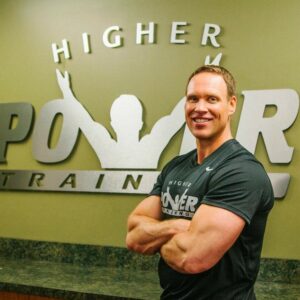Having worked with NFL offensive and defensive lineman, I can tell you, often they have some shoulder pain when bench pressing. Many of these guys have had shoulder surgery and rehab. They are cleared to bench press, but typically still have some pain when performing any press pattern. All of these guys still want to bench, and need to as this lift does have a strong transfer to their position.
In this article, I will teach you tricks to get your athletes pressing pain-free or with a significant reduction in pain. If your athlete does have pain with pressing, it’s imperative that your athlete has been medically cleared prior to implementing these strategies. Here are 6 tricks to get your athletes pressing pain free now:
#1. Perform pulling exercises prior to bench pressing
In most instances, athletes who have pain with pressing typically can perform both horizontal and vertical pulling exercise pain-free. I recommend either completing all your pulls prior to benching, or combining them in a superset with benching. Regarding order, pull first, then press second.
#2. Perform either warm-up sets or work sets of scapular retraction exercises prior to bench pressing
Precede the bench press with scapular retraction work. I recommend lying prone on a 30* incline bench.
The progression is as follows:
- I’s prone 30 degree incline
- A’s prone 30 degree incline
- W’s prone 30 degree incline
- T’s prone 30 degree incline
- These exercises can also be put into a complex. I’s and A’s can be combined. IAT’s also work great as a complex.
- For the preceding exercises, performing 8-15 reps is recommended performed with body weight or dumbbells.
- Advanced exercise: Prone 90/90 shoulder abduction with external rotation. This exercise is advanced since it combines scapular retraction with shoulder external rotation. Perform 8-12 reps of 5 second holds at the top. Start with body weight, progress to very light weight.
All sets can be performed earlier in the workout, or they can be performed in a superset with the bench press, ideally preceding the bench press.
Tips #1 and #2 work by:
- Increasing the temperature of the shoulder joint.
- Warming up and activating the rotator cuff and scapular stabilizers
- Lining up the joint structures for pain-free pressing.
#3. Change the pressing angle
If the flat bench gives you pain, then find an angle that feels better. Athletes that have had a collar bone injury (AC joint) typically can perform overhead work but not flat bench. Athletes that have rotator cuff problems usually are able to do decline bench work, but incline and overhead are not well tolerated. Find an angle your athlete can train with the least pain, and slowly progress the angle overtime.
#4. Change the modality.
Push-ups are usually the best starting place for press patterns. Typically hands elevated push-ups are the most tolerated. A multi grip bar (sometimes called a football bar) may be the second best modality as your athlete may be able to find a grip and elbow position that feels the best. This can be attempted with dumbbells as well, but dumbbells actually tend to be even more advanced due to amount of stability and control from the rotator cuff. Floor presses with a barbell, dumbbell, or football bar can also be used.
#5. Try using chains
If the problem is more related to the rotator cuff, your athlete will most likely have pain in the bottom of the press. In this case, adding chains as a form of additional resistance can do wonders. This works by unloading the pain zone, and overloading the pain-free zone. I have found that the best exercise for pain related to the rotator cuff is decline barbell bench press with chains.
#6. Perform the bench press at the end of the workout
The benefit of putting the bench last is your joints and muscles will be very warm. In addition, due to fatigue, you will need less weight to get a workout. By utilizing one or more of these strategies, your athletes will be able to incorporate the bench press successfully into training. This is important because training with pain really means making no gains.




